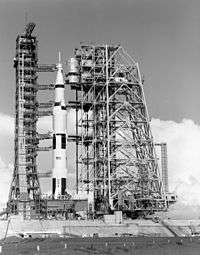Service structure

A service structure, or supply tower or launch tower, is a structure built on a rocket launch pad to facilitate fueling and loading of cargo and crew into a spacecraft.
A supply tower also usually includes an elevator which allows maintenance and crew access. Immediately before ignition of the rocket's motors, all connections between the tower and the craft are severed, and the bridges over which these connections pass often quickly swing away to prevent damage to the structure or vehicle. In contrast with launch towers, service structure towers do not guide rockets as they lift off.
Service structures generally consist of fixed components and mobile ones.
Examples
Kennedy Space Center
The structures at the Kennedy Space Center Launch Complex 39 pads include a rotating service structure that is moved in place around the shuttle stack for the period of time that the space craft sits on the pad prior to launch, usually several weeks. That structure is rotated back out of the way several hours prior to the launch while the fixed service structure remains in place at all times.[1]
Unmanned and manned rockets such as the Delta, Saturn V also used fixed and mobile service structure configurations with the mobile portion moved away from the vehicle several hours before launch.[2] The Saturn's "fixed service structure", however, was formally called the launch umbilical tower (LUT) and was fixed to a Mobile Launcher Platform.
White room

The 'White Room' is the small area used by NASA astronauts to access the spacecraft. The room takes its name from the white paint. First used in Project Gemini, its use and white color continued to be included on supply towers through subsequent programs up to and including the Space Shuttle program.
Rooms are located at the end of the walkway extended from the fixed service structure. In this room astronauts make final preparations before entering the spacecraft such as donning parachute packs, putting on helmets and detaching portable air conditioning units.[3]
Baikonur Cosmodrome
Similarly, Soviet-and Russian-designed service structures such as those at the Baikonur Cosmodrome stand while servicing the vehicle. The entire structure pivots outward and downward out of the way at launch time.
 Launch at Baikonur Cosmodrome Site No. 1
Launch at Baikonur Cosmodrome Site No. 1 Saturn V with fixed (left) and mobile (right) service structures
Saturn V with fixed (left) and mobile (right) service structures
References
- ↑ "Rotating Service Structure (RSS)". NASA.
- ↑ "Fixed Service Structure". NASA.
- ↑ Burgess, Colin (2003). Fallen astronauts: heroes who died reaching for the moon. Bison Books. ISBN 0-8032-6212-4.